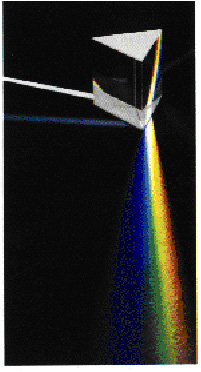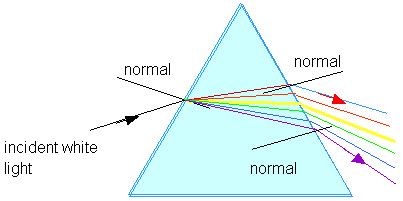|
|

|
|



A prism changes the direction of light as shown in Figure 17.2. Light enters the prism going from air to glass so it is bent toward the normal at this first surface. It travels through the glass and then goes from glass to air. At that second surface it is bent away from the normal. Since the two surfaces are not parallel, the final direction of the exiting light is different than the initial direction of the incoming light. The bending or refraction at each surface depends upon the angle of incidence there and the index of refraction of the glass.

Table 16.1 in the previous chapter lists the index of refraction for several materials. However, if we look more closely, we find that there is a variation in the index of refraction for light of different wavelengths or different colors. Table 17.1 lists the index of refraction for a few kinds of glass for different wavelengths or colors. While the variation is not great, this means that different colors of light, or light with different wavelengths, will be bent different amounts. The index of refraction decreases as the wavelength increases. The index of refraction is less for blue light than for violet light. It is still less for green and for yellow and for orange. The index of refraction is least for red. That means violet light will be bent the most and red light will be bent the least as shown in Figure 17.3.


This spreading of the light into various colors is called a spectrum. The variation of index of refraction (or speed of light) with wavelength is called dispersion. Multiple internal reflections inside a piece of glass, such as a crystal or a pretty goblet or candle holder, allow the differences in angle between the red and violet ends of the spectrum to compound so the exiting spectrum will be spread out even more. This means that as you see little parts of the spectrum coming through one facet, you will see light of a single color. A jeweler may describe these bright, colored lights as "fire" because it is pretty. Diamonds, with their larger index of refraction will have more internal reflections. Diamonds also have a very great dispersion. These two characteristics, and the way a diamond is cut, combine to increase this effect and give a diamond great "fire" and beauty.

A: When light first goes from air into the gem, the angles of refraction for different colors of light are different. At each internal reflection, these differences are increased. Therefore, light that has gone through several internal reflections will have its spectrum spread out through much greater angles. This causes more sparkle or "fire" in the light that comes out.
A: A spectrum of colors is produced because the bending of light of different colors (or wavelengths) is slightly different. Light is bent as it passes through a cylindrical column of water but red light will be bent a different amount than violent light.

|
|